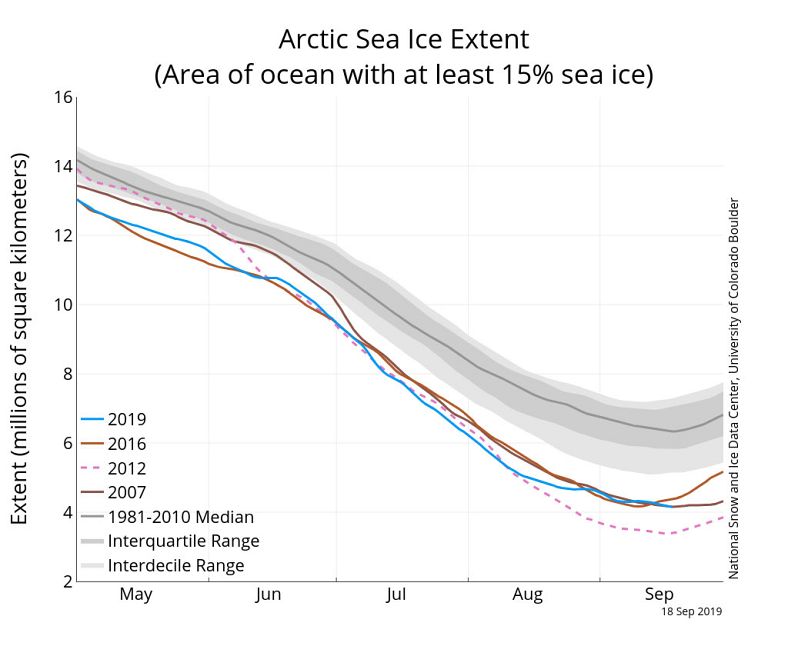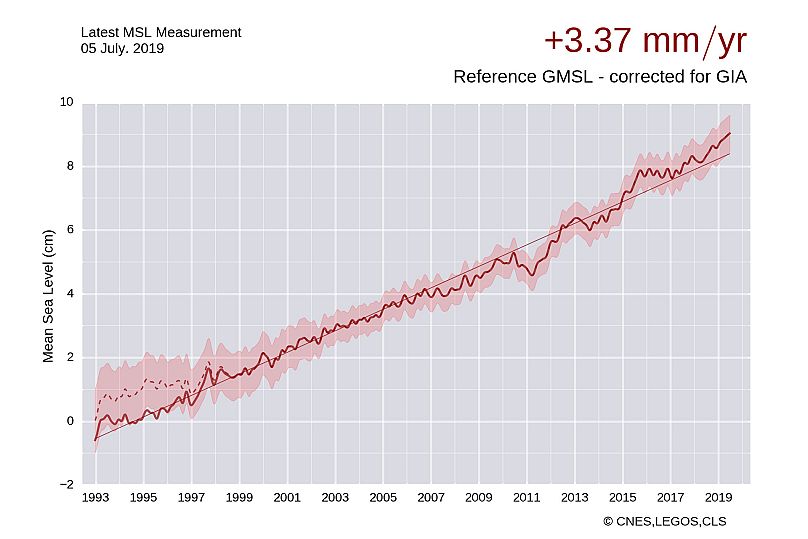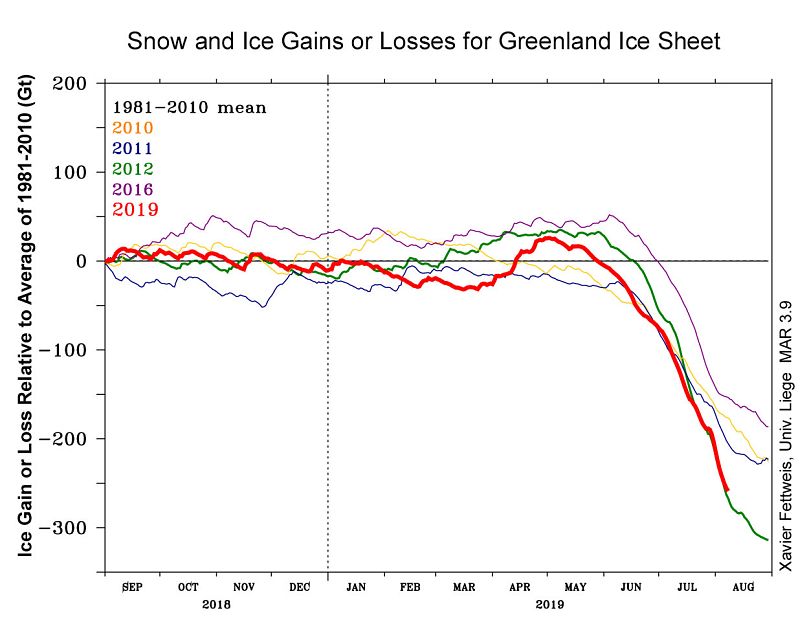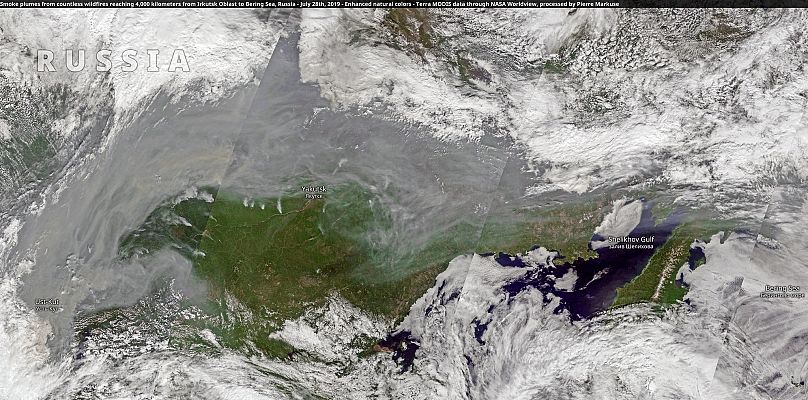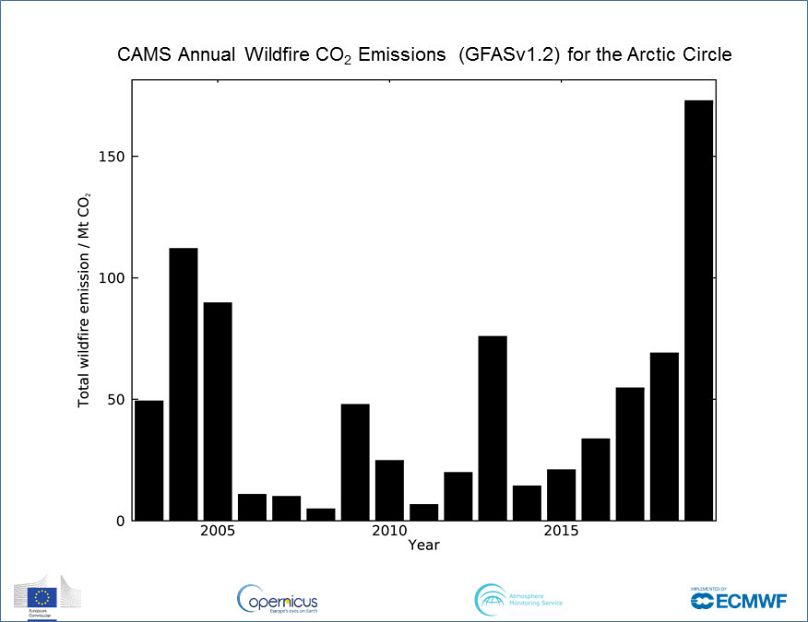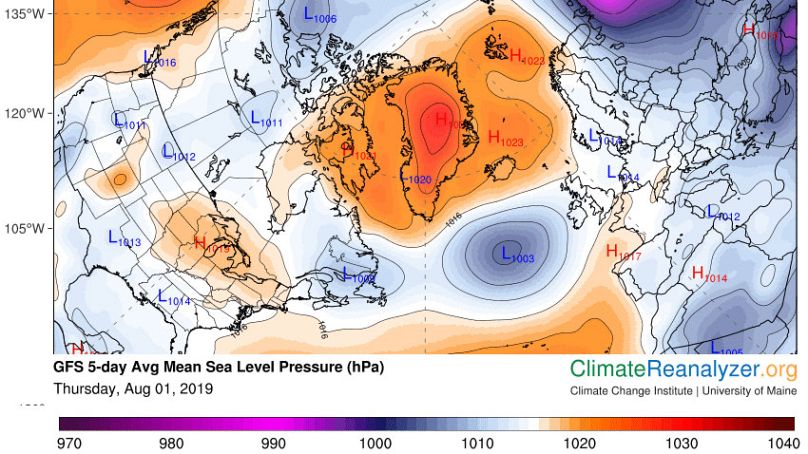Unprecedented wildfires, a record melt of the sea ice and some more extreme weather episodes have marked the 2019 summer season in the Arctic Circle. It was on a par or worse than the 2012 record melt and heat levels, showing that the North Pole is the frontline of the global climate crisis.
Winter is coming slowly to the Arctic. With the arrival of the autumn, the region will set into darkness and the ice and sun will have a truce after another dreadful melt season. Outside of major anomalies occurring, the ice caps and the sea ice will start to recover.
It is widely accepted by the scientific community that climate change is twice as intense in the Arctic Circle than in the rest of the planet. The poles are among the key regulators of the world's weather and climate, acting as a "cooler" for the wind, sea currents and streams.
So whatever happens in the Arctic, impacts all of us.
Despite the record temperatures last boreal summer in the Northern Hemisphere the year 2019 hasn't quite beaten the 2012 melt levels but it's been almost on a par, and has broken records, so let's have a look back to the events that made 2019 a hectic year for the Arctic, and get some expert advice.
The question is, where to start? Reporting on climate change is a difficult exercise between being alarmist or realistic, while fulfilling our duty to keep our audience informed.
But it does seem that being slightly alarmist is the only realistic way to report what the Arctic region has undergone this year.
Record sea ice loss
Last May US Secretary of State Mike Pompeo praised the "new opportunities" of the Arctic. Could we read into that the opportunities presented by the warming of the Arctic? The Arctic resources weren't exploitable in the past, after all. And now it sounds prophetic. Since the last Arctic Council meeting -where the U.S. refused to sign a declaration involving the concept of Climate Change - the region has undergone a record melt of the sea ice.
The trend adjusted mid-August, as shown in the US National Snow and Ice Center interactive chart, and the 2019 melt season won't be as intense as 2012. But it's a close run thing. Experts agree that the ice extent and volume decrease will continue, as the warm ocean waters melt the bottom of the ice sheet.
The sea ice is smaller in surface, but also thinner, so the overall volume is decreasing, pouring millions of tons of freshwater into the oceans. This has as yet unknown consequences in the weather and climate systems as well as in the biological balance of the seas. Not to mention the most direct result: the sea levels rise, also boosted by the water expansion caused by the hotter sea temperatures.
Satellite observations allow scientists to confirm that the rate is accelerating.
However, Mark Drinkwater, head of ESA Earth and Mission Science Division, tells Euronews that sea ice gains were higher than the previous years during the 2018/2019 winter. **"**So it would take a pretty exceptional summer melt to have erased those mass and ice volume gains. We wait to see autumn freeze-up measured data from CryoSat and not model predictions, to calculate the net summer melt mass loss".
Greenland's ice cap - the second largest on Earth after Antarctica's - struggled with an extreme melt event at the end of July, when the second big summer heatwave to hit Europe moved west but the seasonal surface melt extent is still below the 2012 record, but also tied. Climatologist Xavier Fettweis thinks that the Greenland ice cap melt season is over, but it will keep going on for a month or so on the Arctic sea ice.
Drinkwater thinks it's better to wait satellite data to present all the losses and gains as "unless melt loss exceeds the extreme 2012 melt season, it may not be judged so extreme after all. Meanwhile the mass gain from snow accumulation may well have compensated. So we wait for GRACE [Gravity Recovery and Climate Experiment, NASA] follow on satellite data together with CryoSat and IceSAT to assess the net volume and mass loss".
In Greenland the melt season started earlier than usual with an intense melt episode that gave birth to one of the pictures of the year, even if scientists point that it is more a symbolic than a scientific highlight: the sled dogs of Danish climatologist Steffen M. Olsen walking on Greenland's flooded sea ice in early June became viral in a matter of days.
The latest research from French scientists warns that previous climate change estimates might be far too optimistic, and in any case the new models predict dramatic changes for the Arctic, with impacts for the whole planet.
On top of that, the melt of key glaciers from the Himalayas to the Alps keep accelerating as shown on the new Euronews programme Climate Now, adding fresh water to the oceans through the rivers.
Unprecedented wildfires
While the melt remains consistent with the last decades' overall trends, what has been absolutely exceptional in 2019 was the number, and intensity of the wildfires within the Polar Arctic Circle. Siberia was the most spectacular, no doubt. At the worst of the crisis, the smoke covered more than 4.000 kilometres as shown in the satellite pictures taken by blogger Pierre Markuse.
But what gives a full picture of how exceptional the fire season was for the Arctic is the data. Copernicus Atmosphere Monitoring Service senior scientist Mark Parrington shared latest data for the season with Euronews. One of the key indicators to show the wildfires are the CO₂ emissions. The chart shows the annual emissions since 2003 in megatonnes.
Outside but very close to the Arctic Polar Circle, there have been widespread wildfires in Alaska, Canada or even a comparatively small but long lasting one in Greenland. The peak in wildfires in the region started mid-June and didn't calm down until mid-august, according to the data provided by Parrington.
"Certainly the scale and duration of the fires within the Arctic Circle has been highly unusual based on the data that we have in CAMS and the years that I have been monitoring high latitude fires. If next year we see something on a similar scale in that region then it would indicate that the summer of 2019 has been a tipping point in terms of fires" he told Euronews. He highlights the impact of the extra gases poured into the atmosphere to the global carbon cycle - already quite congested - but studies and calculations on how it will affect climate are yet to be assessed by the scientific community.
Parrington says that he wasn't particularly surprised with the first wildfire data in June, but by the end of the month, when he realised they never actually stopped and got the CO₂ emissions, was very surprised. "It is concerning as this summer's fires are a clear indicator that the climate and environment is changing in the Arctic Circle in a way that we haven't seen in observations before. The amount of smoke pollution emitted by the fires is also a very serious concern from an air quality and health perspective and it has been widely shown in the media over the last couple of months that the effects of this can reach very far from the source region and have impacts on air quality thousands of kilometres away" Parrington stated by email to Euronews.
Record breaking temperatures
July was the hottest month ever recorded on the planet and the Arctic Circle was no exception.
Alaska saw its most freakish summer ever with widespread wildfires and its hottest month ever recorded in July. But that's much like the Earth itself. In addition to that, unusually warm temperatures left Alaska with no sea ice, at all. High sea temperatures triggered algae blooms and there have been episodes of sudden death of thousands of animals: salmons, birds, but also marine mammals, since the springtime. Anchorage reached 32,2º C.
In Canada, also ravaged by wildfires, the permanent military base of Alert at only 900 kilometres from the North Pole reached the record breaking temperature of 21º C on July 14. Quebec, Ontario and Nova Scotia suffered a major heatwave, with temperatures that felt like 45º C with humidity in Montreal.
September starts in Canada with a new sea heatwave, together with "regular" heatwave poised to bring "july-like" temperatures.
Temperatures in Markusvinsa, in northern Sweden, on the border of the Arctic Circle, hit 34.8°C on July 26 according to a NOAA report. Norway's Polar Arctic Circle's town of Saltdal reached 34.6º C.
September is also being exceptionally warm in Alaska or Norway.
.
Arctic permafrost thawing
Let's not forget to mention the quick melt of permafrost that keeps occurring. Latest data suggests that greenhouse causing gas methane emissions are being fueled by this side effect of the Arctic warming.
According to a UN draft report seen by French news agency AFP, 33% to 99% percent of the world's frozen soils could melt by the year 2100. In June a team of Alaska researchers concluded that permafrost is thawing 70 years earlier than previously expected. Melt permafrost liberates greenhouse effect gas methane as well as bacteria and the consequences are yet to evaluate.
Tipping point?
So, can we panic now? Scientists are reluctant to tell us "there's no way back". They tend to prefer to tell us that this is coherent with the global warming warnings they have been sending for years now.
Interviewed by Euronews, Belgian climatologist Xavier Fettweis - an expert on Greenland - states that we are not at a tipping point yet. "We use this word in climatology for "a non return point " when the consequences will be irreversible even if the climate is coming back to normal values. For the ice sheets for example, it is when the ice sheet thickness will be too small, preventing the ice sheet to rebuild. For reaching a tipping point, we need several decades with such a summer".
However, Fettweis admits that it is happening faster than expected. "After the 2012 summer, we though that it was just a big anomaly due to the natural variability and that the Arctic climate would come back to more normal summer conditions afterwards. But the fact that the same kind of anomalies happened again observed this summer suggests that 2012 and 2019 records are perhaps not due to the natural variability but a consequence of global warming which is currently warming the Arctic much faster than it was predicted by the IPCC". He also points out that several summers since 2007 have also outdone the Intergovernmental Panel on Climate Change predictions. "The circulation anomalies (persistence of high pressures) observed this summer have been the highest since 1950" he says.
One of the immediate consequences of a low sea ice extent is the anomalies in the Polar Vortex in the winter, as it happened in the United States, he says. Fettweis thinks that the IPCC forecast hasn't taken into account the current anomalous weather patterns caused by a long-term negative North Atlantic Oscillation. He warns the scientific community that global warming is faking the previous climate and weather predictions since 2013. "As a citizen, I see that during this summer, all the alarm signals have turned red and that it is time to move before it's too late. I think that the time to reduce the greenhouse gases emissions is perhaps even shorter than expected".
Far reaching consequences we don't understand
Drinkwater says he's not personally comfortable with "tipping point" concept. "Certainly there have been a coincidence of several fairly extreme events this summer - though none of these are really beyond the envelope of what have been previously anticipated or predicted given the pace of Arctic warming" he states. "Clearly the boreal forest fires have been exceptional (Alaska, Siberia and Greenland), as well as occurrence of intense Arctic storms with lightning close to the North Pole. So it is clear that there is a worrisome pace of change in the Arctic region with far reaching consequences which we don't yet fully understand. What is also clear is that such extremes drive considerable year to year variations which are now evident in our satellite data timeseries" he adds.
Climate scientist and Ph.D Candidate Zachary M. Labe doesn't want to speak about thresholds crossed. "This summer was certainly full of extreme events in the Arctic. However, I don't believe there is scientific evidence to suggest any tipping points were reached. Tipping points are not well defined in climate science. I also think they distract from the main message, which is that long-term trends point to rapid Arctic climate change. Internal variability (weather) is extremely important for year-to-year changes in Arctic sea ice, the Greenland Ice Sheet, and Siberian wildfires. However, the long-term trends remain consistent with Arctic Amplification - that temperatures are rising more than twice as fast as the global average".
For Labe, tireless updating his Twitter followers with the latest data, the most concerning as a citizen is that these conditions are impacting indigenous communities and marine life here and now. "Unlike other parts of the globe, it is clear that the effects of climate change are already being felt in this region. We need to remember that people live in the Arctic, and their communities are being negatively impacted by Arctic climate change today".
Crucial week ahead
Euronews will bring you coverage and analysis of upcoming events beginning with the global climate strike on Friday 20 September all the way through to the end of the Climate Action summit.
Follow euronews' coverage on the climate crisis on this page.












